#Oneota vessel
Text

Over 9,300 pottery sherds were collected during 2008 excavations at one of the sites in the Sand Lake Archaeological District, near Onalaska, Wisconsin. Of those, nearly 160 rims and decorated body sherds were categorized into likely ceramic wares and types based on their grit or shell temper, form, and decoration. But categories created by archaeologists today to make sense of what people made in the past cannot neatly cover everything. A small group of anomalous sherds, all from different excavation units, had distinctive characteristics but defied classification into types. One grit-tempered rim (upper left) flares to a flattened lip and has a cord marked exterior surface. Another cord roughened grit-tempered sherd (upper right) thins to a rounded lip. It may fit the local Middle Woodland type Shorewood Cord Roughened. A third rim has a cord impression over a folded lip (lower right). It is grit-tempered but might also contain shell temper, a possible mix of Terminal Late Woodland and Mississippian clay preparations. One grit-tempered body sherd has parallel tool trails (lower left). It could be from a Terminal Late Woodland type vessel or from a rare grit-tempered Oneota pot.
31 notes
·
View notes
Photo
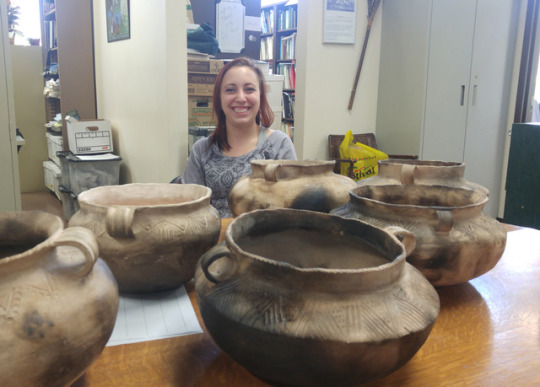
#tbt to a month ago when we visited @uwlmvac, where Sarah Schultz has been experimenting with re-creating Oneota-style pottery vessels! Sarah donated one to us for our teaching collection and one to the Baxoje Wosgąci: Iowa Tribal Museum and Culture Center. It was great to visit our WI colleagues!
#iowa#wisconsin#archaeology#oneota#experimental archaeology#pottery#ceramics#art#tbt#throwback thursday
14 notes
·
View notes
Photo

A broken Oneota vessel fills a small pit-type feature uncovered during the 2002 excavations at the Meier Farm site (47LC432), near Onalaska, Wisconsin. This site was part of the Sand Lake site complex, where tens of acres of ridged agricultural fields were created in the moist soils of a trapped floodplain. Meier farm was one of the habitation areas associated with those fields. Most of the Sand Lake complex has since been obliterated by development.
#archaeology#archeology#Oneota#Oneota vessel#Oneota pottery#pottery#ceramics#Oneota ceramics#Meier Farm#Sand Lake
28 notes
·
View notes
Photo

This Oneota vessel was found in the early 2000s in an storage/refuse pit at the Sanford Archaeological District in La Crosse, Wisconsin. In profile the pit was flat bottomed with contracting walls. The design on the vessel fits a type called Brice Prairie Trailed that is most common in the earliest phase of the Oneota occupation of La Crosse: the Brice Prairie phase, ca. A.D. 1300–1400. The impressions on the interior of the lip are characteristic of Brice Prairie phase vessels. The shoulder looks as though it has round punctates above tool trails, but the round holes are actually the tops of “stab and drag” trails, where the tool was pushed into the top of the shoulder and then dragged downward. Charred plant remains from the pit yielded a corrected and calibrated radiocarbon date of A.D. 1387–1444 (70%, UGA 01751).
#archaeology#archeology#Oneota#Oneota pottery#Oneota vessel#Oneota ceramics#Sanford Archaeological District#ceramics#vessel#Brice Prairie
12 notes
·
View notes
Photo

This vessel was recovered during excavations in the early 2000s at the Sanford Archaeological District in La Crosse, Wisconsin. The vessel looks like a possible hybrid of Perrot Punctate and Brice Prairie Trailed v. zigzag motifs. This vessel has vertical tool trails that start at the top of the shoulder, and two rows of punctates forming zig-zags on the neck. It has a diameter of only 12 cm (2 3/4 inches) (53 percent of the rim was present) and a high neck (3.5 cm or 1 1/3 inches) for such a small diameter. This vessel was found in a feature which also produced a Perrot Punctate vessel and a Brice Prairie Trailed vessel. All three represent large portions of the vessels.
6 notes
·
View notes
Photo
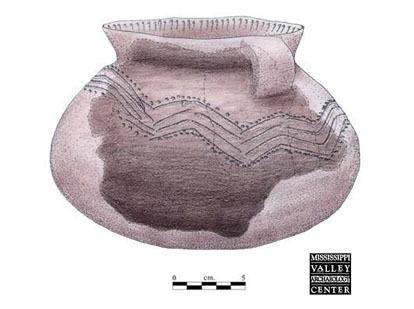
Drawing by Meg Rivers of a typical Oneota globular vessel form.
16 notes
·
View notes
Photo

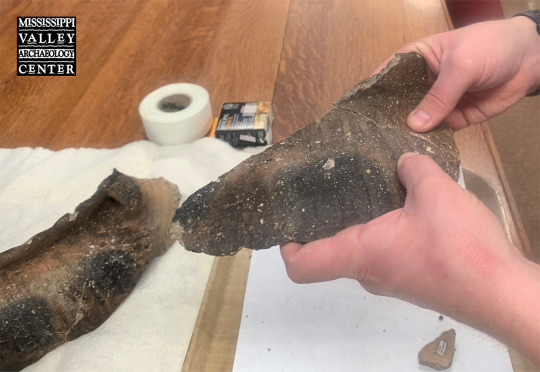
Thanks to Wendy Holtz-Leith and Erik Anderson for this week’s post –
In 2012 MVAC excavated about 500 Oneota features exposed during the reconstruction of STH 35/2nd Avenue in downtown Onalaska. One unusual discovery was a nearly complete vessel found crushed in place at the base of a feature. Vessel 45, as it was later numbered, was represented by well over a hundred fragments of varying sizes.
Reconstructing a vessel is much like putting together a three-dimensional jigsaw puzzle, with quite a few pieces missing. You typically begin with the edges, which in the case of pottery, means the rim. Rim fragments from Vessel 45 were reassembled, and decorated body pieces were glued together and attached to the rim. Then came the slow process of figuring out where the undecorated pieces went. Some parts of the vessel were easier to figure out. Sherds from the base were thicker and in some cases larger, making it easier to fit them into place.
After most of the pieces were glued into larger sections, it was time to glue those sections together to form the whole vessel. This task was complicated by three things. First, some small joining fragments were missing. Second, errors in forming a vessel’s curved shape tend to creep in during the gluing and drying. Right after gluing, refitted pieces are usually placed in a sandbox to dry, and any shift can alter the curvature, making subsequent joins difficult. Third, the exterior had scorch marks or firing smudges that made its color quite variable—sometimes even adjacent sherds were completely different colors. In the end the vessel was fully reconstructed (albeit precariously), but it was left in a few very large segments because of those subtle errors from gluing.
The reconstructed vessel is very large and slightly oblong. It has a moderately high, slightly everted (outward-flaring) rim with bold finger impressions on the lip top to exterior lip. There are two handles on opposite sides of the vessel. The shoulder decoration consists of alternating panels of 12 or 13 vertical trails made with either a finger or a broad tool, and four nested chevrons with rectangular punctations below. There are four panels of nested chevrons, one under each handle and the others midway between them. The oblong rim has a diameter of 36.5 cm (14.4 inches) at the handles and ~34 cm (13.4 inches) midway between the handles. The motif is typical of the type Perrot Punctate, with very bold lip-top impressions typical of the Pammel Creek phase, A.D. 1400–1500.
#archaeology#archeology#Oneota pottery#pottery#Oneota ceramics#ceramics#Wendy Holtz-Leith#Erik Anderson#Pottery Reconstruction#Ceramic Reconstruction
17 notes
·
View notes
Photo

This shell-tempered Oneota vessel portion was found in La Crosse County in 1991. The rim flares outward and has tool impressions on the lip top. The tool was held flat, and the impressions were made at an angle rather than being perpendicular, creating a series of diagonal dashes / / / along the lip. The shoulder has blocks of diagonal tool trails made at different angles.
8 notes
·
View notes
Photo

Throwback Thursday - Robert "Ernie" Boszhardt excavating an Oneota vessel at the Sanford Archaeological District in La Crosse, Wisconsin, summer 2001.
(Photo contributed by J. Theler.)
#archaeology#archeology#Sanford Archaeological District#Oneota#Pottery#Ceramics#Oneota pottery#Oneota ceramics
15 notes
·
View notes
Photo
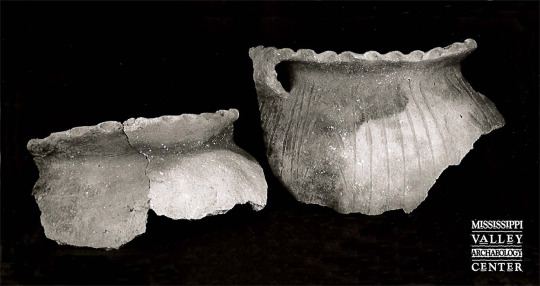
Excavations at the late precontact Oneota Pammel Creek site just south of La Crosse, Wisconsin, in the late 1980s revealed a large number of sherds and vessel portions that show evidence of burning after the pots broke. This is indicated by discontinuous charring on the edges of larger fragments. Some vessel portions also have smoked or partially smoked surfaces. Those with partially smoked surfaces include sherds with irregular, sharp boundaries between the blackened and unblackened areas. These patterns indicate that the unblackened areas were covered and thus protected from charring. The shapes of the unblackened patches suggest they were covered by another sherd.
It’s unclear why these sherds were burned before they were discarded in refuse pits, but from the large number, it seems to have been a common occurrence--and therefore, perhaps intentional. Similar sherds have been found at other local Oneota sites as well. One possible explanation is that the sherds were stacked over new vessels during the firing process to form a simple kiln.
18 notes
·
View notes
Photo
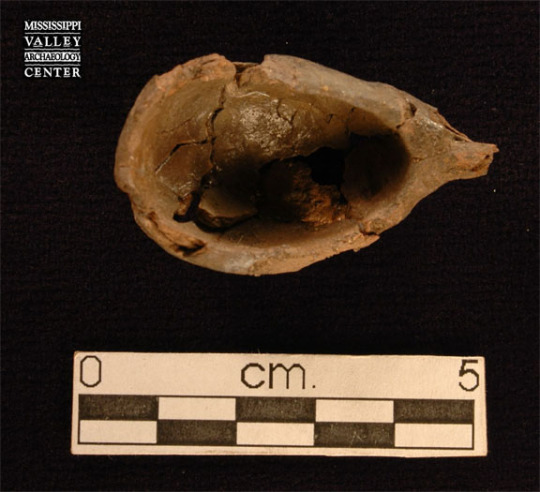
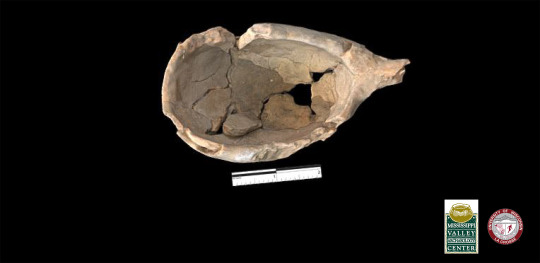
This small, spoon-like vessel made of fired clay was found during excavations at an Oneota site in the Sanford Archaeological District in La Crosse, Wisconsin, in the early 1990s. Such spoons are extremely rare in the area. Fragments of a similar spoon have also been found at an Oneota site in Onalaska.
Link to 3D image: https://sketchfab.com/3d-models/ceramic-spoon-oneota-culture-la-crosse-co-wi-da9ffef1babb496d8fa1de75e1a9320a
3D scan courtesy Dr. David A. Anderson, Associate Professor, UWL, Department of Archaeology & Anthropology.
#archaeology#archeology#ceramic spoon#ceramic spoon-like vessel#Sanford Archaeological District#Dr. David A. Anderson
3 notes
·
View notes
Photo
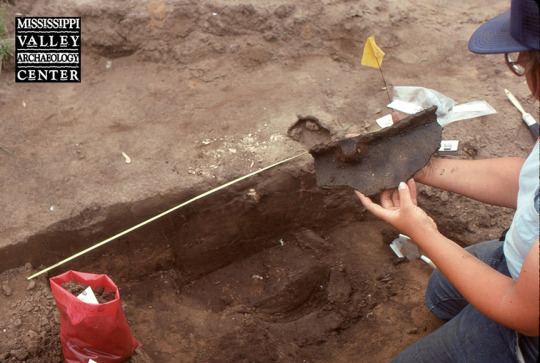
Connie Arzigian lifts an Oneota rim sherd with handle from a pit feature at the Pammel Creek site (47LC61) in May 1989. This site is the type site for the Pammel Creek phase (A.D. 1400–1500) in the local Oneota sequence. The bold finger impressions on the lip of the vessel are typical for pottery from this phase. The Pammel Creek site is located south of La Crosse, Wisconsin.
14 notes
·
View notes
Photo
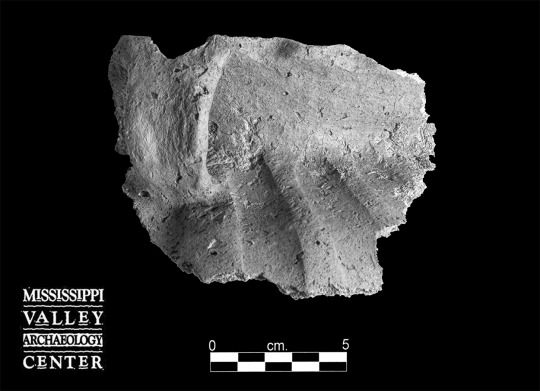
This Koshkonong Bold rim sherd was recovered from an Oneota circular basin, storage/garbage pit. It has lip top to exterior finger (wide) notches, giving the rim a pie-crust appearance. The vessel has a wide strap handle that tapers toward the bottom. The handle is attached below the lip and has no decoration. This rim dates to the Pammel Creek phase occupation of the site. Recovered during 2008 excavations at the Sand Lake Archaeological District, located north of La Crosse, Wisconsin.
#archaeology#archeology#Oneota#Koshkonong#$Pottery#Ceramics#Oneota pottery#Oneota ceramics#Sand Lake Archaeological District
8 notes
·
View notes
Photo

This Oneota vessel was excavated in 1991 from a site south of Holmen, Wisconsin that consisted of a tight cluster of up to 85 pit features situated on a sandy rise surrounded by dark compact organic soil. Evidence suggests that cultural activities of relatively short duration took place at the site somewhere ca. A.D. 1450-1650.
The vessel consists of a large rim and decorated shoulder section and a rim and handle that belongs to the same vessel but does not attach to it. The rim is 0.79 cm (.311 in) thick and 4.48 cm high (1.76 in) (measured on the vessel exterior). It is only slightly out-flaring. The lip surface is notched by placing a tool flat on the lip at a right angle to the rim. The resulting tool impressions form "dimples" on the surface of the lip. The shoulder of this vessel has shallow tool trails that are about 0.63 cm (.24 in) wide which form bands of intersecting lines. The handle has three vertical finger trails of varying width. It attaches to the rim just below (0.83 cm, .32 in) the lip and has a maximum width of 4.60 cm (1.8 in).
4 notes
·
View notes
Photo
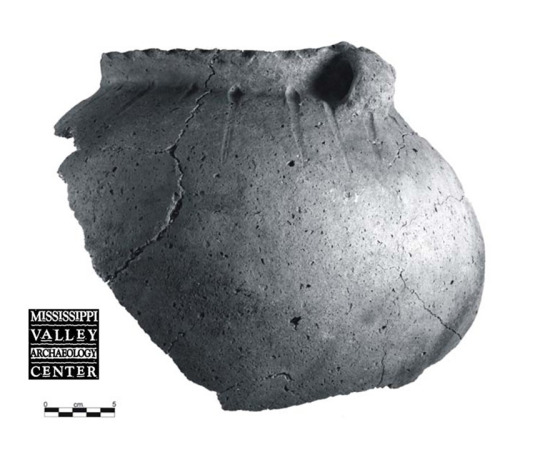
This large vessel section, called Vessel 108, was found in the early 2000s during excavations in the Sanford Archaeological District in La Crosse, Wisconsin. This late precontact Oneota site was inhabited during all three phases of the local Oneota occupation. Vessel designs and decorations provide clues to an Oneota vessel’s age. The rim of Vessel 108 has bold notching on the lip top to exterior lip, and the shoulder has a probable Pammel Creek Trailed motif of vertical finger trails. The trails begin at the top of the shoulder and are wide at the top, trailing off to nothing by the break in the shoulder. The vessel also has an undecorated strap handle attached just below the lip and a short rim height of 33.6 mm. The design and decoration—especially the bold impressions on the lip—are characteristic of the Pammel Creek phase (ca. AD 1400–1500), the middle phase of the Oneota occupation.
#archaeology#archeology#Oneota#ceramics#pottery#Oneota ceramics#Oneota pottery#Sanford Archaeological District#Pammel Creek Trailed
10 notes
·
View notes
Photo

Thanks to Jim Theler for this week’s post –
Throwback Thursday - Shown here is Robert "Ernie" Boszhardt at the Meier Farm (47LC432) excavation in 2002. He is holding a pottery vessel rim with a handle attached. This sherd is assigned to the pottery type "Midway incised variety bold" of the Pammel Creek phase (AD 1400–1500) of the local Oneota occupation.
5 notes
·
View notes